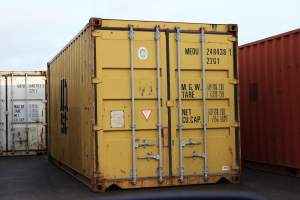- Have any questions?
- 0477 003 432
- 0428 801 500
- sales@truebluecontainers.com.au
Things To Consider When Buying Shipping Containers
Buying Shipping Containers in Perth, Australia.
There’s a lot to consider when buying a shipping container, this isn’t your everyday purchase, after all. We’re on your side though and are fully prepared to help you down the path of how to buy a shipping container.
We’re going to cover every aspect that we can think of and answer some of the more common questions you may have, like “how much does a shipping container cost?”, and more. Read on for our comprehensive list of things to know before buying a shipping container.
Know What’s Out There
Before we delve into the nitty-gritty of buying or renting shipping containers, you need to know what’s available to you. For example, at True Blue Containers, we offer you several choices when it comes to our shipping containers, including, but in no way limited too:
* New
* Used
And, within the above three buying options, there are many types of containers for you to choose from. These include:
* 8′ mini cube
* 10′, 20′ and 40′
* General purpose
* High cube
* Side door
* Open top
* Flat rack
* Refrigerated
* Dangerous goods storage shipping containers (compliant to AS1940-2004)
Now, we know that having this much choice can be daunting, but don’t worry about it. We’ve got you covered.
How Big is a Shipping Container?
Containers come in a variety of different shapes and sizes, but for the purpose of this blog, we’re going to focus on the two main types of shipping containers, which are:
* Standard – How big a shipping container is can vary, but, most standard containers are available in lengths of 40, 20, and 10 feet. And, when it comes to their width, this is a standard of 8 feet. But, with this said, you should know that the dimensions can differ, because some shipping containers are used to store specialist equipment that is obscurely designed. Dimensions can also depend on the extra attention and safety regulations that are required for the storage of hazardous materials.
* High Cube – These can serve a multitude of outcomes and come in height of 2-9m high, depending on your needs. For example, a 20-foot, high cube container can store up to 76 square metres of internal volume, and a gross weight of 30 480 kg.
What Are the Next Steps?
Now that you know what options are available to you, it’s time to make a decision. But, before you do, think about what purpose you need your container to serve. This will heavily impact the kind of container you choose.
Containers can serve multiple purposes, aside from their obvious function of shipping and transportation. Some of their other practical uses include:
* Temporary office space on building and mining sites
* Event spaces
* Conversion into micro houses/apartments
But, these aren’t their only purposes, as containers can be used for so much more, you just need to get creative with them. What’s great about using containers for offices or event spaces is that they can be implemented pretty much instantly and removed just as quickly.
How Much Does a Shipping Container Cost?
As you can imagine, the price of shipping containers, whether new, or used depends on a number of factors. Things to consider when it comes to how much a shipping container costs include:
* Extra features such as windows, doors, and refrigeration
* Condition of the container
* Inspection and safety certificates
* Delivery location
Now, when it comes to shipping container rentals from True Blue Containers, costing depends on the period of your rental, whether it be short or long-term. But, as a general guide, a standard 20-foot shipping container with a rental period of more than 6 months, will cost you around $100 per month. But, if you’re looking for something more extensive, like a 40-foot refrigerated container, you’re looking at a figure of up to $1,100 per month.
What Do You Need to Look Out For?
The next thing to know before buying a shipping container is how to conduct a proper inspection on a used container. If you’re buying a new container, you’ll still need to inspect it, but not as thoroughly.
Take the following steps for a thorough inspection of a used container:
1. Walk around the exterior perimeter and look down each side of the container to make sure that they’re straight.
2. Keep an eye out for dents and rust (note that with used containers, some small dents and occasional patches of rust are to be expected). Large dents are also not too much of an issue.
3. Be on the lookout for large sections of rust and corrosion, these are both red flags.
4. Inspect rust closely. Is the metal flaking and weakened?
5. Check the roof of the container for rust and signs of leaks.
6. Move inside the container and give it a sniff. Does it smell of mold? If it smells of mold, then it’s likely to be leaking.
7. Make sure the container is watertight by closing the doors while you’re inside and look for sunlight entering the container.
8. Take out a torch and take a look around. Pay close attention to the wooden flooring and make sure there aren’t any holes.
9. Check that the container’s identification code is intact.
Any More Questions?
Whether you’re looking to buy or rent a new or used shipping container, look no further than True Blue Containers. We can offer you competitive prices, high-quality, and professional services. If you have any questions or are looking for a quote, get in touch with us.

